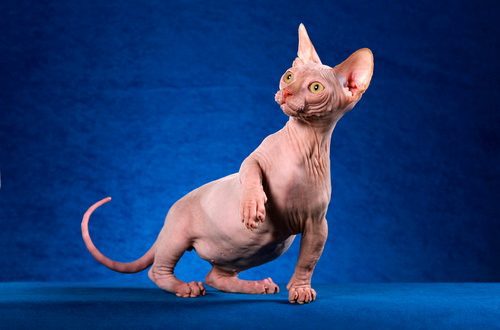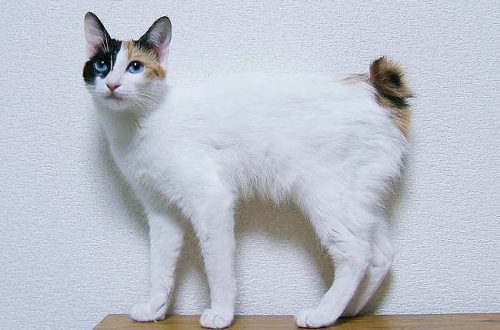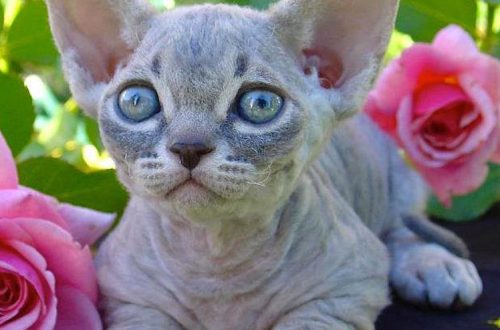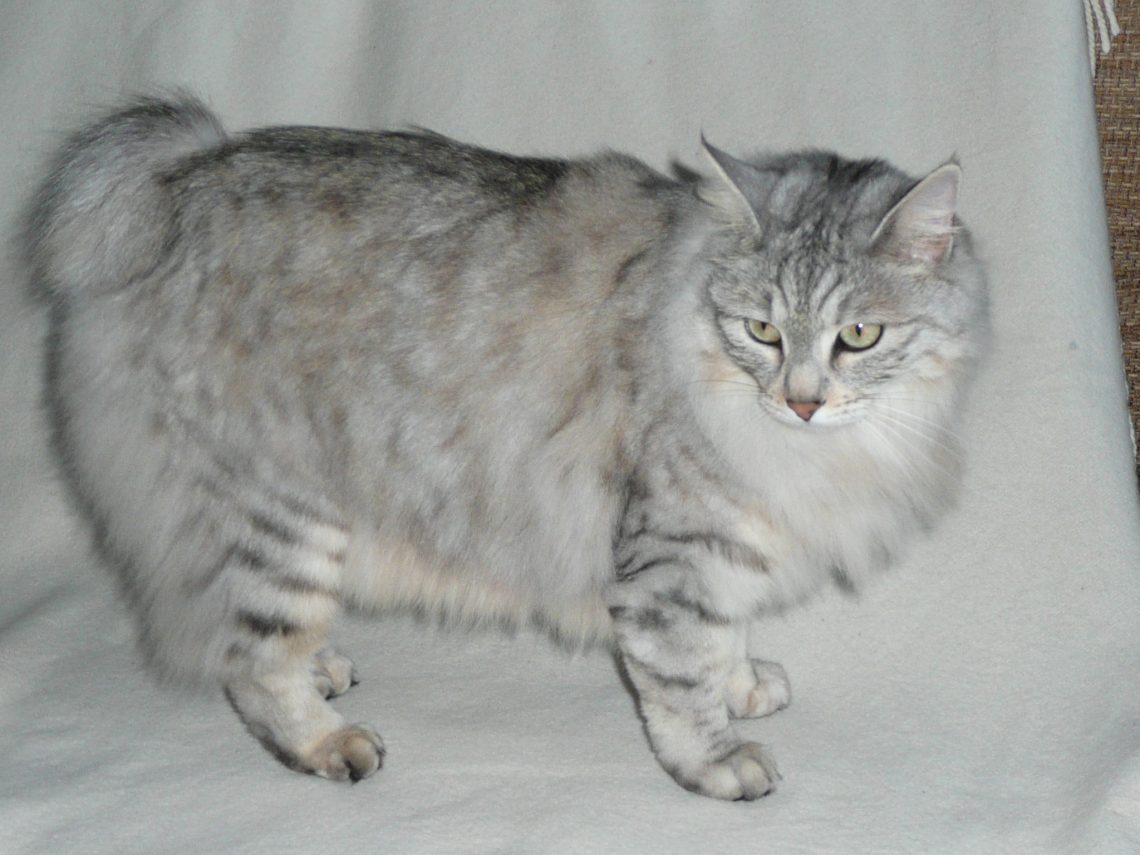
Kurilian bobtail
Other names: kurilets , bobtail , kurbobik
The Kurilian Bobtail is a short-tailed native of Russia. This breed attracts by contrast: the appearance of a lynx coexists with the restlessness of a hare, and dog devotion – with a truly feline nobility.
Contents
- Characteristics of Kurilian bobtail
- Basic moments
- History of the Kurilian Bobtail breed
- Video: Kurilian Bobtail
- Appearance of the Kuril Bobtail
- The nature of the Kuril Bobtail
- Kurilian bobtail Education and training
- Care and maintenance
- Health and disease of the Kuril Bobtail
- How to choose a kitten
- How much is the Kurilian Bobtail
Characteristics of Kurilian bobtail
| Country of origin | Russia |
| Wool type | Shorthair, longhair |
| Height | up to 30 cm |
| Weight | 3–8 kg |
| Age | 12–17 years old |
Basic moments
- The tail in the form of a pom-pom is a distinctive feature of the breed, which was inherited by the “smokers” from their Japanese relatives.
- There are two varieties of Kurilian Bobtail: shorthaired and longhaired.
- Despite the outward resemblance to wild cats, representatives of this breed are very sociable and friendly.
- “Smokers” show a truly canine devotion to the members of the family in which they live. The favorite is often one person.
- Bobtails get along well with children and make strong friendships with them, taking an active part in even the craziest game.
- Representatives of the breed do not show discontent when in the company of other pets, but it is worth keeping them away from decorative rodents and birds.
- Kurilian bobtails tend to periodically show independence and willfulness, testing the patience of their owner for strength.
- These animals practically do not mark the territory, which makes them ideal for keeping in an apartment.
- The breed is absolutely unpretentious in care and therefore suitable even for people with minimal experience in keeping cats.
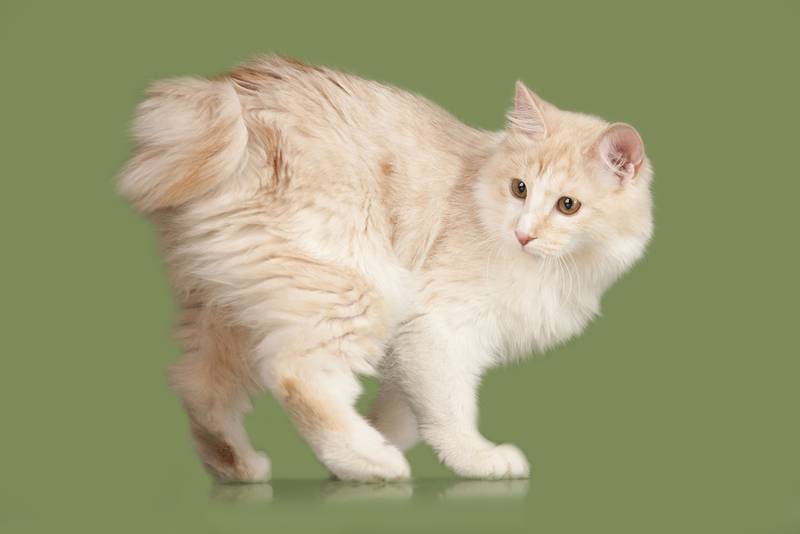
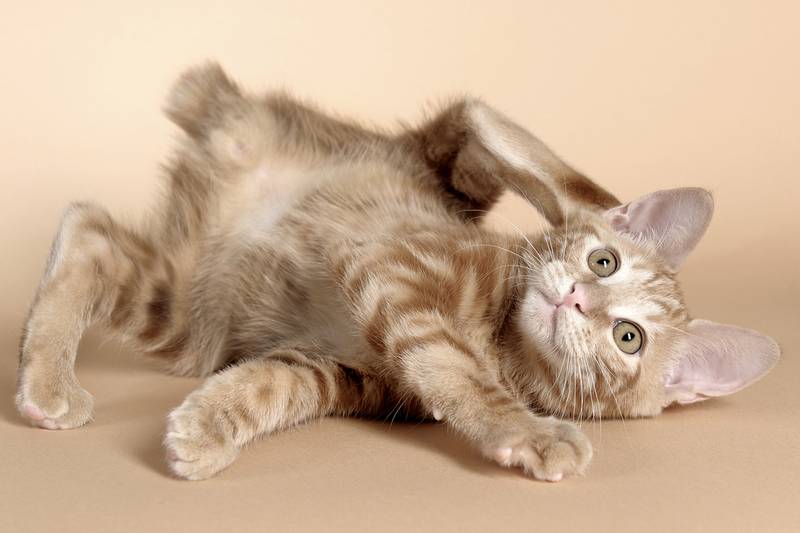
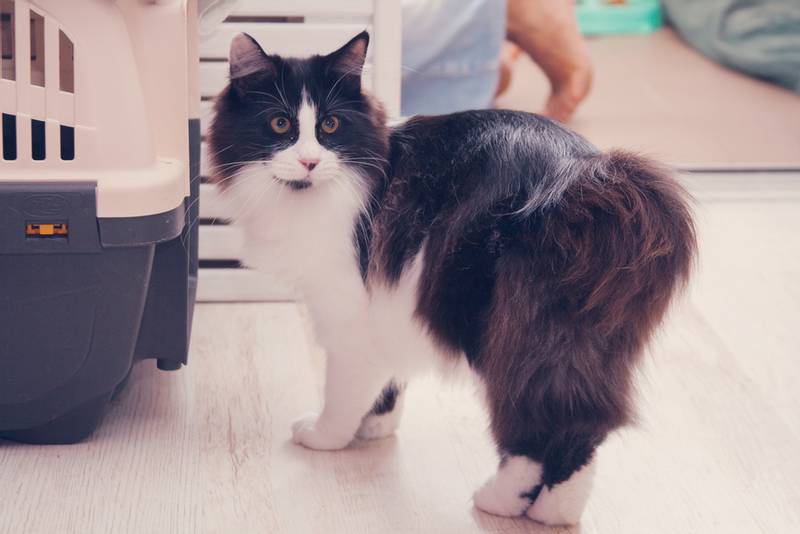
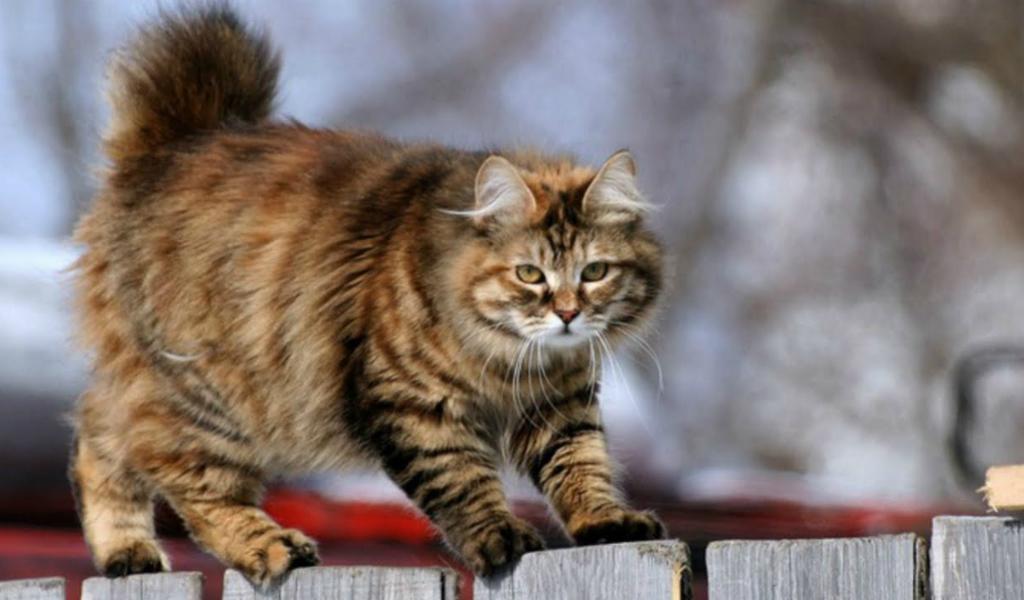
The Kurilian Bobtail is a breed that cannot be confused with another. The reasons for this are a short, as if docked, tail and an uncharacteristic physique for cats. No less remarkable is the character of the bobtail. Calm, peaceful and friendly – this is how their owners speak about these cats. A developed hunting instinct is another characteristic feature of a small “lynx”, so representatives of the breed feel great in the countryside. However, their reputation as skillful predators does not suffer in urban conditions either: not a single annoying fly will escape the close attention of the bobtail!
History of the Kurilian Bobtail breed
The Kuril Islands (namely, the southern part of the archipelago) are a stumbling block between two powers: Japan and Russia. The right to own these lands was repeatedly disputed until the Kuriles fell under the wing of the Russian Federation. Together with the territory, the state also secured the right to be considered the birthplace of one of the most remarkable and unique breeds in the world.
According to the point of view of most felinologists, the Kuril Bobtails are descended from short-tailed cats that have inhabited the archipelago since at least the 18th century. Their progenitors were presumably feral and came from the union of the Japanese Bobtail and Siberian cats . The history of the appearance of these breeds on the Kuril Islands is no less interesting.
Ancient beliefs of the Land of the Rising Sun say that Japanese bobtails were considered a symbol of good luck and therefore were overprotected by the locals. In addition, these animals had a sacred origin: their ancestors were considered white temple cats that guarded the shrines of the followers of the Buddha. Some bobtails came to the archipelago along with the Japanese as part of research or military expeditions. Often they were also used as guards of the imperial farms, where fur animals were bred. Obeying their instincts and wanting to escape from the “golden cage”, many cats escaped into the wild. Several generations later, Japanese bobtails acquired new features, trying to adapt to harsh living conditions: the fear of water disappeared, the claws stopped retracting into the paw pads, and their owners became larger.
As for the Siberian cats, they came to the Kuriles along with the settlers. Animals easily made friends with the feral “Japanese”, and as a result of this union, a new breed arose, now known as the Kuril Bobtail.
It is worth noting that the selection of these animals did not begin immediately. Despite the relatively long appearance of the breed, felinologists paid attention to it only at the end of the 20th century. Up to this point, breeders visited the Kuril Islands and left with bobtails, mistaking them for their Japanese counterparts. Then no one imagined that charming short-tailed creatures were something new in the already rich cat world. However, things have changed since 1991.
It was then that new representatives of the breed were brought from the Kuril Islands. In October, the first standard for the Kuril Bobtail was adopted, and the Soviet Felinological Organization (SFO) played an important role in this. Tatyana Bocharova, observing the selection of cats, came to the conclusion that a short tail is inherited by all animals, which meant the absence of any anomalies in their development. By registering the “smokers” as an independent breed, the Siberian Federal District set itself a new task – to achieve similar recognition among European felinologists.
December 1994 was marked by a seminar at which Russian breeders put forward a proposal to refine the Kuril Bobtail breed standard with a view to its recognition by the international organization WCF. The official registration of short-tailed cats took place only a year later, which provoked a sudden outbreak of European interest in an unusual breed. Increasingly, in Italy, Germany, Poland and the Czech Republic, cat shows began to be held, the frequent guests of which were precisely the Kuril Bobtails. By that time, nurseries had already appeared that specialized in breeding two varieties of the breed: long-haired and short-haired. At the same time, the first category was divided into individuals with a long and semi-long coat.
In 2001, the felinological association of CIS clubs at the coordinating meeting further clarified the standard, but it remained unchanged. This prompted the FIFe felinological organization to officially register the breed three years after this event. In 2012, the Kurilian Bobtail firmly established itself in the lists of the American association TICA.
The mid-90s was a turning point in the fate of the representatives of the breed. Since 1995 and to this day, the Kurilian Bobtail “capture” more and more territories, conquering the hearts of people. These cats are valued in many European countries for their gentleness and good nature, but in their historical homeland, bobtails are popular mainly with hunters and fishermen – largely due to the excellent instincts of animals. However, this breed is still not as popular as the beloved British , Persian or Siamese cats .
Video: Kurilian Bobtail
Appearance of the Kuril Bobtail
Representatives of the breed have a very contrasting appearance. The squat growth hides a developed and strong musculature, which allows the animals to make huge jumps. Kurilian bobtails are distinguished by a high degree of sexual dimorphism: cats are several times larger than cats. So, their weight is 7.5 and 4-5 kg, respectively.
The Kurilian Bobtail is a medium-sized breed. The heritage of wild ancestors can be equally traced in the appearance of individuals of both categories of the breed – long- and short-haired.
Head and skull
The head has the shape of an equilateral triangle, the outlines of which are gently rounded (this is especially evident when the animal is in profile). In adult bobtails, it is more like a trapezoid, and the reason for this is the cheeks with delineated and full mustache pads. The skull is flat.
Muzzle
The Kurilian Bobtail is the owner of a rather wide and rounded muzzle. The stop is indicated only formally and practically does not catch the eye. The flat forehead goes into a straight and wide nose of medium length. His lobe is well defined. A strong chin is developed and has a smooth outline, visible in profile. The cheekbones of the animal are not as low as those of their Siberian counterparts.
Kurilian bobtail Ears
Triangles of medium size are set high and fairly wide. In this case, the distance between them corresponds to the width of the base of the ear, but in no case can it be less. The ends are softly rounded. Long-haired Kurilian bobtails wear “decoration” on them in the form of small tassels, giving the animals an even greater resemblance to a lynx.
Eyes
They are shaped like a walnut: oval at the top and slightly rounded at the bottom. They are notable for the fact that they are slanted in an oriental way, and this gives the look of the animal an exquisite mystery. The eyes are set wide enough and “lie” on a line that runs from the nose to the base of the ears. The pigmentation of the iris is predominantly yellow or green; in bicolor and white animals, blue is found. In general, the standard also provides for a discrepancy between the color of the eyes and the color of the bobtail.
Jaws and teeth
The presence of strong jaws is due to the lifestyle of the feral progenitors of the breed. Existing in the wild, cats were forced to independently earn their own food. The bite is tick-like; the dental formula is complete. It consists of incisors, canines, premolars and molars.
Neck
Not long enough, strong muscles can be felt under thin skin. Due to the thick woolen cover, it seems plump.
Frame
The Kuril Bobtail has a dense and strong body, which at any moment is ready to demonstrate flexibility unexpected for an animal. The muscles do not weigh down the appearance of the cat. The body has an elongated shape. The chest is developed, the back line is distinguished by an arched bend. The croup of the animal is slightly raised.
Tail
The Kurilian Bobtail is notable for its short and slightly curved tail, which rises above the line of the back. Its length varies between 3-8 cm, but in long-haired individuals it can reach 13 cm. There are four types of animal tail.
- “Stump” consists of deformed and firmly connected to each other vertebrae (no more than eight). It can be straight or slightly bent down in the manner of a hook.
- “Spiral” includes 5-10 vertebrae. This type of tail is one of the most characteristic of the breed.
- The panicle consists of the same number of vertebrae as the spiral. It has a straight shape, less than the usual tail by a third of the length.
- “Retracted Bobtail” includes 5-7 vertebrae, the line of which twists into an impromptu loop towards the end of the tail. Considered a breed defect.
The shape of the pom-pom is not regulated by the standard. His grooming is acceptable and even preferable.
Kurilian bobtail limbs
The hind limbs of the bobtail are not much longer than the front ones. Relief muscles are the main reason for the phenomenal jumping ability of animals. Compact paws have a rounded shape, the fingers are tightly compressed. The claws do not retract and, when in contact with the surface, make a clicking sound, more characteristic of dogs than cats.
wool cover
The type of coat of the “smoker” depends on its belonging to a particular breed variety.
- The short-haired bobtail is the owner of a thin and short coat. It is permissible to increase its length on the tail, as well as on the back and undersides of the body of the animal.
- The long-haired bobtail, as the name implies, has a coat of long or medium length. As with its shorthair counterpart, this Kurilian Bobtail has longer hair on the underside and back of the body. In addition, it is notable for the “collar”, “pants” and lynx tassels on the tips of the ears.
Both varieties of the breed are distinguished by a thick undercoat.
Color
The Kurilian Bobtail is notable for the fact that its color can be almost any. The most common options are smoky, tabby (tabby), bi- and tricolor. The breed standard does not recognize Burmese, Abyssinian, lilac and chocolate colors.
Possible vices
Among the defects of the Kuril Bobtail breed are:
- forelimbs of insufficient length;
- deep-set and/or protruding eyes;
- excessively short or long tail;
- a pronounced curve of the back line;
- pointed tips of the ears;
- high “landing” of the cheekbones;
- lack of undercoat;
- elongated body;
- narrowed head.
Disqualifying faults include:
- short tail without bends and kinks;
- tail exceeding 13 cm in length;
- undescended one or two testicles;
- erosion of the mucous membrane in the anus;
- spinal deformity;
- amputated claws;
- absence of a tail;
- deafness
The nature of the Kuril Bobtail
In contrast to the outward resemblance to a wild and impregnable lynx, representatives of the breed are distinguished by genuine friendliness and affability. This greatly accelerates the rapprochement of cats with new owners. The Kurilian Bobtail will not sit frowning under a chest of drawers and snort in annoyance in response to your attempts to get him out of a temporary shelter. On the contrary: these animals love to communicate and are actively involved in joint games with family members. “Kurils” are often called dogs in a cat’s body, as they happily bring toys and balls thrown by the owner’s deft hand.
By the way, a very reverent relationship is born with the family of the Kuril Bobtail. For representatives of this breed, there is nothing more important than close people who give them sincere love and care. The animal will protect the family in which it lives, exclusively “like a dog”: becoming in a formidable stance and meowing in warning. At the same time, the bobtail will especially patronize one person whom he considers his master. If you managed to take this honorary pedestal in the heart of a fluffy guard, the pet will follow on its heels, communicating in its own language and taking all possible part in your life.
Kurilian bobtails are the best suited for families with children. The animal will never intentionally scratch the baby, but, on the contrary, will endow him with excessive “whiskered” care. “Kurilets” will not show aggression even if the child accidentally pulls his tail or ear. Instead of hissing and resenting for the whole day, the bobtail will happily engage your child in a game of hide and seek or demonstrate a newly learned trick that will certainly cause sincere children’s laughter.
Representatives of the breed get along well with other pets. Cat or dog – it doesn’t matter: the Kuril Bobtail will find a common language with both the serious Maine Coon and the playful Dachshund . However, it is strongly not recommended to keep decorative birds and rodents in the same house with a bobtail. A hunting instinct that has not awakened in time can turn into a tragedy, and your attachment to an animal can turn into grief for a lost feathered or furry friend.
Along with meekness and good nature, this breed is distinguished by its wayward and independent character – this is what many owners of the Kuril Bobtail say. Animals do not like to sit on their hands for a long time, depicting a plush toy, and will soon try to leave the heated place. In the absence of proper attention from the owner, the “smokers” begin to live by their own rules and soon consider themselves the full owners of the territory, namely your apartment. At the same time, it will not be easy to overthrow the short-tailed usurper. Even the slightest glimmer of luck will soon turn into a defeat for you: the pet will begin to protest. Spoiled things, torn blinds or curtains, an overturned sugar bowl – and this is not the end of the Kuril Bobtail’s vendetta.
Do you think that your pet is too lazy and less and less involved in games? Take a day off from work and go with the animal to the country, where it will appear before you in a completely different guise. A dexterous hunter in the blink of an eye will force out the domestic bumpkin from the Kuril Bobtail. In the fresh air, representatives of the breed are especially active: they track down prey for several hours without closing their eyes; fight with neighbor cats for free territory; poke their curious nose into every remote corner of the house, while emitting a purr reminiscent of bird trills.
Kurilian bobtail Education and training
Kuril Bobtails are the owners of a developed intellect, which allows animals to understand the meaning of more than a thousand words! Raising a pet is not difficult: the main thing is to correctly determine the boundaries of what is permissible. You should not raise your hand to the cat, because there are other ways to tell your pet about your displeasure. Strict tone is enough. This tactic also works if you want to stop the bobtail from inappropriate behavior. The word “no” will certainly prevent undesirable consequences.
If the pet nevertheless escaped your close attention and naughty, have an educational conversation as soon as possible. Otherwise, the bobtail will not understand what exactly he managed to do wrong.
Upon reaching a certain age, the “smokers” begin to test the owner for strength, making attempts to take a leading position in the house. At this stage of education, you will need to be able to adequately respond to the behavior of the animal and make it clear that you do not plan to give way to a wayward furry friend.
Otherwise, the upbringing of the Kurilian Bobtail is not difficult, especially for people with a strong character. Teaching pets to use the tray and scratching post for its intended purpose is also not difficult.
Representatives of this breed are easy to train. Their inquisitive mind allows them to learn new tricks and adopt the skills of their tailed brethren. Turn the training process into an exciting game – and soon the bobtail will delight you with the brilliant execution of commands!
Care and maintenance
The Kurilian Bobtail does not need careful care – and this is another plus in favor of the breed. Even long-haired bobtails do not cause unnecessary inconvenience to the owners.
Since the undercoat in cats is moderately developed, the coat almost never gets tangled, and the procedure for combing the Kuril Bobtail does not become a daily hard labor. One or two times a week is enough. It is recommended to purchase a special brush with metal teeth or a glove with silicone growths to remove dead hairs. When combing, follow the direction of hair growth.
Bathing for bobtails is one of the most favorite ways to spend time, but you should not abuse it: the skin becomes dry and the outer hair becomes thin. Using special mild shampoos and conditioners will not save the situation. Bathe your pet only if it gets dirty. Collect warm water in a basin or sink, and then put the cat there. Apply the shampoo to the coat, carefully spread it over the entire body of the Kuril Bobtail and rinse. After bath procedures, the pet must be thoroughly dried. For short-haired cats, a towel cocoon is perfect, but long-haired cats will need a hair dryer.
From their ancestors, the Kuril Bobtails inherited the inability to fully retract their claws. For this reason, they grind down perfectly both while the pet is walking and when it interacts with the scratching post. However, it still does not interfere with acquiring a special device for shortening them. Cut off only the tips, otherwise damage the thin vessels.
Do not ignore the eyes of your pet. They need to be washed several times a week using a clean, lint-free cloth or cotton wool soaked in a special product (available at the pet store). When rubbing your eyes, move your hand from their outer corner to the inner. With a similar frequency, the ears of the bobtail should be examined, wiping them with a cotton pad soaked in a special lotion. Otherwise, sulfur will accumulate in the auricles, which in the future can lead to the development of infectious diseases.
When it comes to oral care, brushing your cat’s teeth once a week is enough. At the same time, the use of “human” pastes is strictly prohibited. Get a special nozzle on your finger to greatly facilitate the procedure. Do not forget that in case of emergency, you can use a regular toothbrush.
Representatives of this breed are extremely unpretentious in food, but this does not mean that you can feed your pet scraps from the table. For a show-class Kurilian bobtail that regularly participates in exhibitions, it is best to purchase premium food. For animals of the “breed” and “pet” categories, ordinary food is suitable, combined with natural food, in particular, with boiled meat.
Do not include in the diet of the Kuril Bobtail:
- some vegetables: potatoes, legumes, eggplant;
- fish (exception – low-fat sea);
- raw and fried meat;
- bakery products;
- dairy;
- pork and lamb;
- tubular bones;
- smoked meats;
- sweets.
There should always be filtered fresh water in your pet’s bowl.
Health and disease of the Kuril Bobtail
Cats inherited good health from their Siberian ancestors, which rarely causes unnecessary trouble for their owners. There are no specific or genetic diseases in this breed, but individual diseases are still common among the Kuril Bobtails. Among them:
- cracks and inflammation of the anus mucosa;
- rectal prolapse;
- urolithiasis disease;
- haemorrhoids.
Excellent animal immunity does not exclude the possibility of developing infectious and parasitic diseases. Regular vaccinations and visits to the veterinary clinic are a guarantee of your pet’s health and longevity.
How to choose a kitten
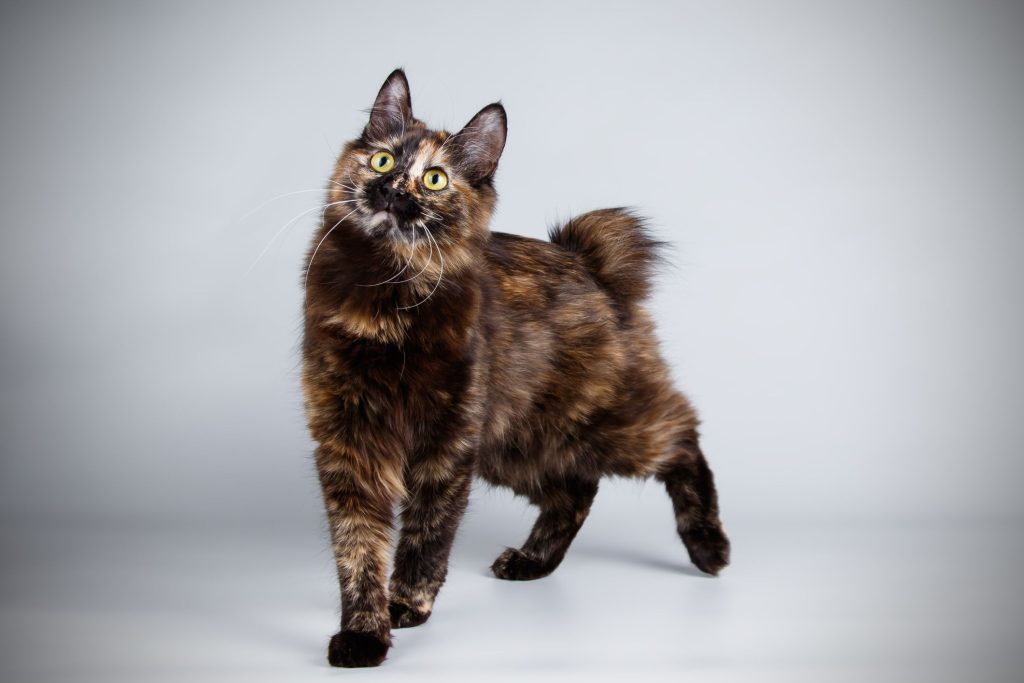

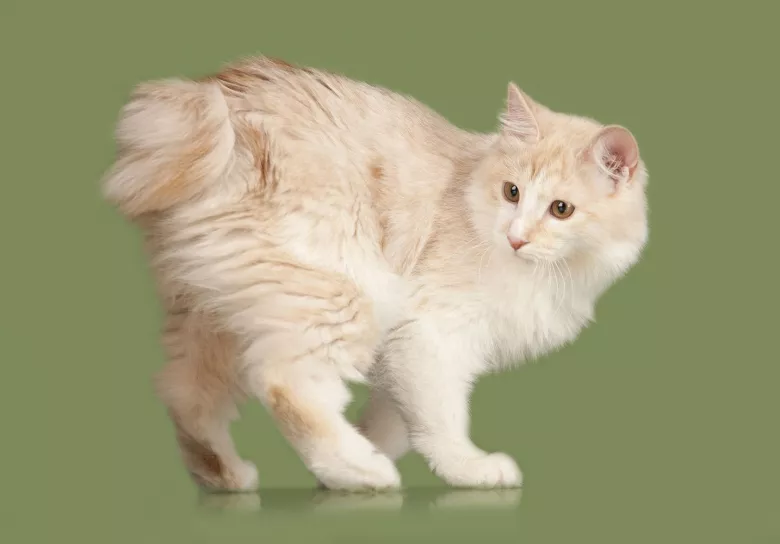

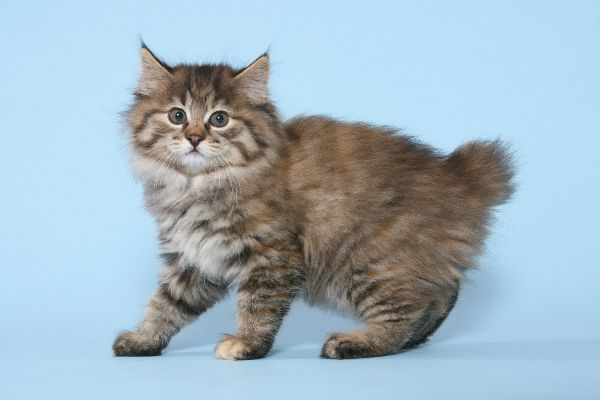

Purchasing a Kurilian Bobtail kitten is a responsible step that requires intuition and attentiveness from you! It is important to notice among the frolicking kittens exactly the one who sinks into the soul. At the same time, you should not listen to the words of the breeder, or to the advice of friends and relatives: this is your pet, therefore, you need to focus only on your premonitions.
The ideal age for a Kurilian Bobtail to buy is three months. It is at this time that the baby begins to show independence and gradually wean from maternal care. In addition, a three-month-old “Kurile” already has a fairly balanced psychological health, so he quickly gets used to new family members.
If the pedigree of the future pet plays an important role, ask the breeder to acquaint you with the necessary documentation or, preferably, with the parents of the babies. This is one of the easiest ways to understand what to expect from your bobtail. The breeder is not talkative and does not show a desire to tell as much as possible about his wards? This is a warning sign: it means that he has something to hide from curious and persistent buyers like you.
When choosing a kitten, you should focus on his behavior among his fellows. Is the baby active and cheerful, happy to get involved in the game and shows a healthy curiosity towards you? This is your pet! Refrain from buying lethargic and shy kittens: in the future, this may turn into unpleasant consequences.
How much is the Kurilian Bobtail
As is the case with other breeds, the ideal place to purchase a Kuril Bobtail is kennels that specialize in breeding this breed. The price of a charming baby starts at 150$; the upper bar is limited to 350 – 400$. In general, the cost of a bobtail is determined by the prestige of the cattery, the presence of a noble pedigree and the class of the kitten (show, breed or pet).
It is worth noting that this breed also has a fourth class – “novice”. It consists of individuals brought directly from the Kuril Islands. The origin of these animals is unknown, but if it’s unprincipled for you to become the owner of a pet with noble ancestors, go for it! In any case, the Kuril Bobtail will become a devoted friend and companion.





